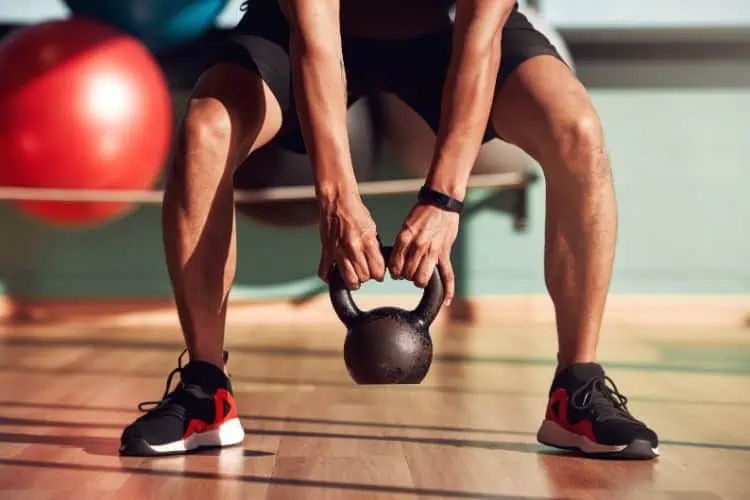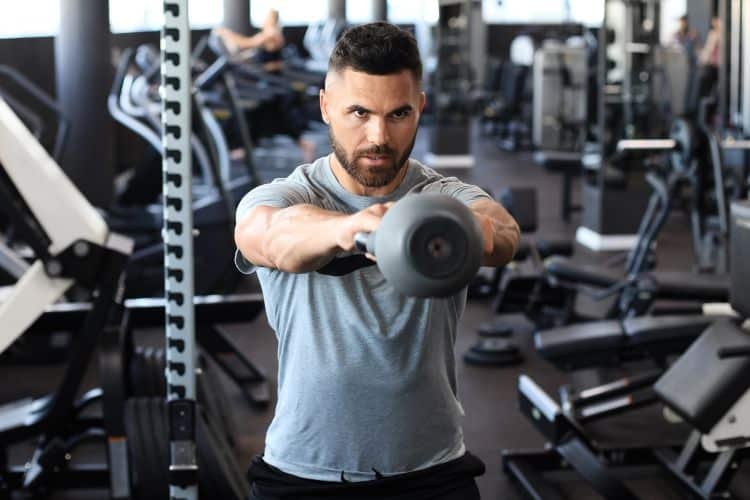

Kettlebell swings have gained immense popularity in the fitness world, and for good reason. This dynamic exercise combines strength, endurance, and power, offering a full-body workout in one efficient movement. Whether you are a seasoned athlete or a fitness beginner, kettlebell swings can provide significant benefits. In this article, we delve into the advantages of incorporating kettlebell swings into your routine and provide practical workouts to get you started.
What Are Kettlebell Swings And What Benefits Do You Get From It?
Kettlebell swings are a compound exercise that involves swinging a kettlebell from between your legs to chest or shoulder height. The movement is powered by a hip hinge and explosive hip extension, making it an excellent functional exercise. The two primary variations of kettlebell swings are:
- Russian Kettlebell Swings: The kettlebell is swung to chest height.
- American Kettlebell Swings: The kettlebell is swung overhead.
Both variations engage multiple muscle groups, making them a versatile addition to any workout program.
Benefits of Kettlebell Swings
1. Full-Body Workout
One of the standout benefits of kettlebell swings is their ability to engage the entire body. The exercise activates the posterior chain—including the glutes, hamstrings, and lower back—while also targeting the core, shoulders, and arms. This makes it a highly efficient movement for those looking to maximize their workout in a limited amount of time.
2. Improved Cardiovascular Fitness
Kettlebell swings elevate your heart rate quickly, making them a powerful cardiovascular exercise. Performing high-repetition swings can mimic the intensity of a sprint, improving both aerobic and anaerobic fitness levels. This makes kettlebell swings an excellent choice for HIIT (high-intensity interval training) workouts.
3. Enhanced Strength and Power
The explosive nature of kettlebell swings builds strength and power in the hips and lower body. This movement translates to improved athletic performance in activities like sprinting, jumping, and lifting. Additionally, the grip strength required to hold and control the kettlebell enhances forearm and hand strength.
4. Core Stability and Posture Kettlebell Swings Benefits
Kettlebell swings require significant core engagement to stabilize the spine and maintain proper form throughout the movement. This not only strengthens the core but also promotes better posture by targeting the muscles that support the spine.
5. Calorie Burn and Fat Loss
Kettlebell swings are a high-intensity exercise that burns a significant amount of calories in a short period. The combination of strength and cardio elements leads to an increased metabolic rate, making it easier to achieve fat loss goals. Studies have shown that kettlebell workouts can burn up to 20 calories per minute, comparable to running at a six-minute-mile pace.
6. Functional Fitness
Unlike isolated exercises, kettlebell swings mimic real-life movements, making them highly functional. They improve mobility, stability, and coordination, which are essential for daily activities and sports performance. The hip hinge movement in kettlebell swings is particularly beneficial for lifting tasks and reducing the risk of lower back injuries.
7. Versatility and Convenience Kettlebell Swings Benefits
Kettlebells are compact and portable, making them an ideal workout tool for home gyms or outdoor sessions. With just one kettlebell, you can perform a wide variety of exercises, including swings, squats, and presses, eliminating the need for extensive equipment.
Kettlebell Swing Workouts
Incorporating kettlebell swings into your routine can be as simple or advanced as you like. Here are some effective workout ideas for different fitness levels:
Beginner Workouts For Kettlebell Swings Benefits
1. Basic Swing Circuit
- Warm-Up: 5 minutes of light cardio and dynamic stretches.
- Workout:
- 3 sets of 15 Russian kettlebell swings.
- Rest for 30 seconds between sets.
- Cooldown: Stretch your hamstrings, hip flexors, and lower back.
2. Swing and Rest
- Perform 10 kettlebell swings every minute for 10 minutes.
- Rest for the remainder of each minute after completing the swings.
Intermediate Workouts Kettlebell Swings Benefits
1. Swing Ladder
- Perform the following sequence with minimal rest:
- 10 kettlebell swings.
- 15 kettlebell swings.
- 20 kettlebell swings.
- Rest for 1 minute and repeat the ladder 3 times.
2. Swing and Squat Combo
- Warm-Up: 5 minutes of dynamic movements.
- Workout:
- 10 kettlebell swings.
- 10 goblet squats.
- 3 rounds with 1-minute rest between rounds.
- Cooldown: Stretch your quads, glutes, and shoulders.
Advanced Workouts
1. HIIT Kettlebell Swings
- Perform 20 seconds of kettlebell swings followed by 10 seconds of rest for 8 rounds (Tabata style).
- Rest for 2 minutes and repeat the circuit 2-3 times.
2. Full-Body Kettlebell Circuit
- Complete the following exercises as a circuit:
- 15 kettlebell swings.
- 10 kettlebell deadlifts.
- 10 kettlebell clean and presses (5 per arm).
- 10 kettlebell lunges (5 per leg).
- Rest for 1-2 minutes and repeat for 3-4 rounds.
Tips for Safe and Effective Kettlebell Swings
To maximize the benefits of kettlebell swings and reduce the risk of injury, follow these essential tips:
- Master the Hip Hinge: Ensure your movement originates from the hips rather than the lower back. Push your hips back and snap them forward explosively.
- Choose the Right Weight: Start with a moderate weight that allows you to maintain proper form throughout the exercise. Gradually increase the weight as you build strength and confidence.
- Maintain a Neutral Spine: Avoid rounding or overextending your lower back. Keep your chest up and shoulders back.
- Engage Your Core: Keep your abdominal muscles tight to stabilize your spine and prevent excessive arching.
- Control the Swing: Avoid letting the kettlebell pull you forward. Use your hips to generate power and maintain control over the kettlebell’s movement.
- Breathe Effectively: Exhale forcefully on the upward swing and inhale as the kettlebell returns downward.
- Warm-Up and Cool Down: Prepare your body with a proper warm-up and conclude your workout with stretches to improve flexibility and recovery.
Common Mistakes to Avoid
Even experienced lifters can make mistakes with kettlebell swings. Here are some common errors and how to fix them:
- Relying on the Arms: The power should come from your hips, not your arms. Focus on the hip thrust to drive the kettlebell upward.
- Rounding the Back: Always maintain a straight spine to avoid placing undue stress on the lower back.
- Lifting Too Heavy Too Soon: Start with a manageable weight to master the form before progressing to heavier kettlebells.
- Neglecting the Core: Weak core engagement can lead to instability and poor form. Tighten your abs throughout the movement.
Kettlebell swings are a powerhouse exercise that offers numerous benefits, from building strength and endurance to burning calories and improving functional fitness. Their versatility and efficiency make them an excellent addition to any workout routine, regardless of fitness level. By incorporating kettlebell swings into your regimen and following proper form, you can unlock their full potential and achieve your fitness goals.




